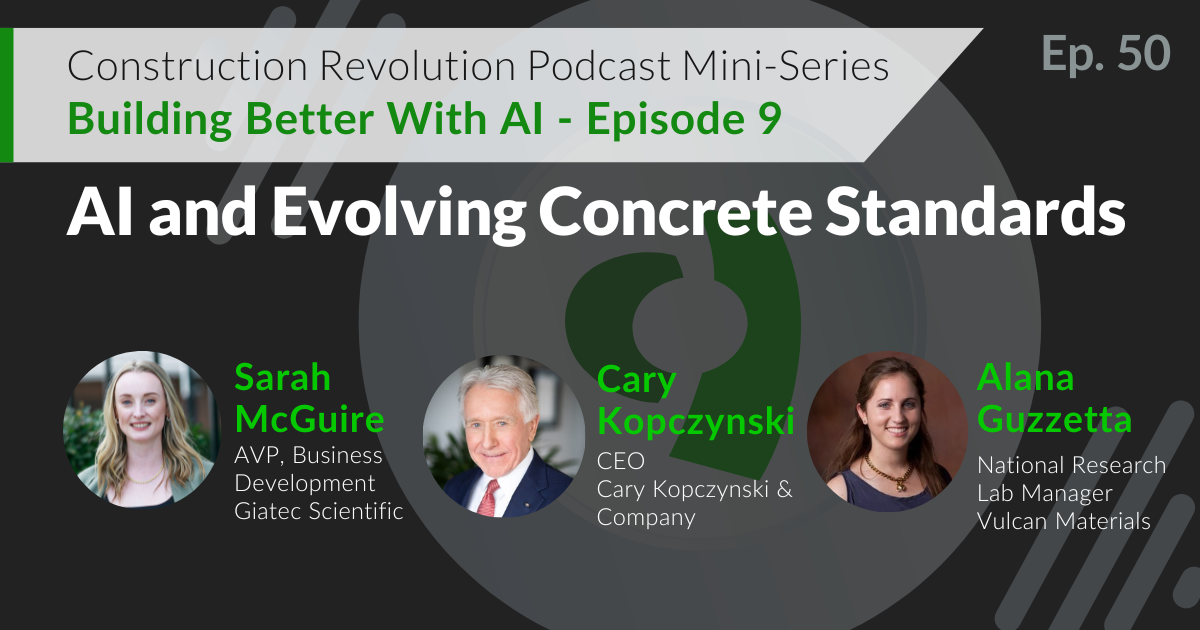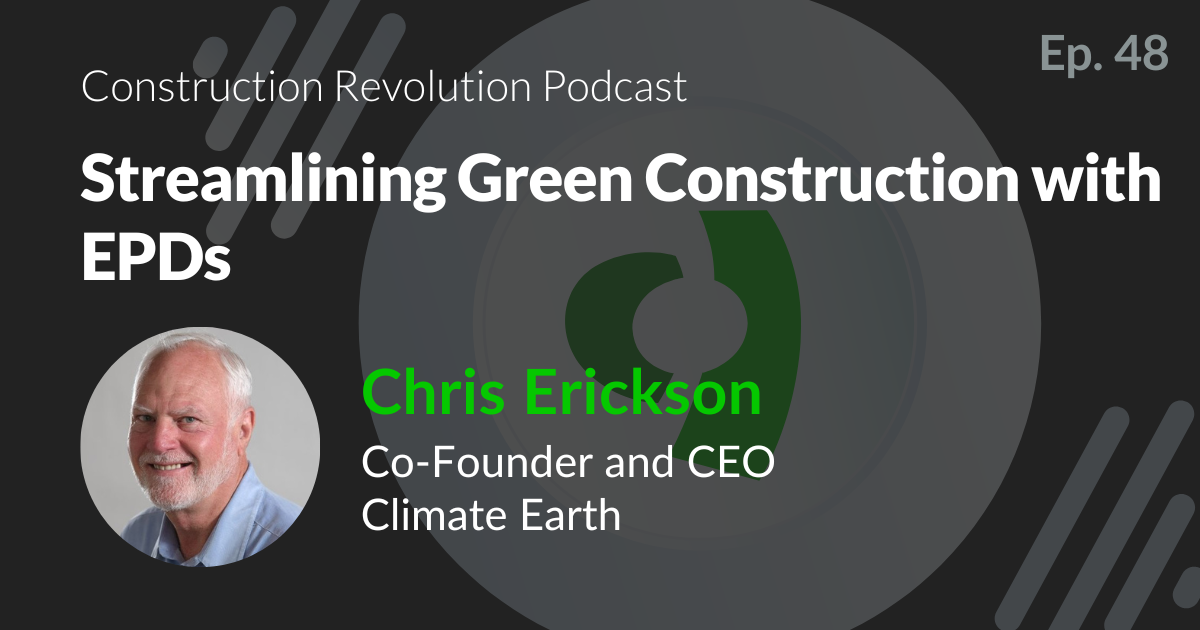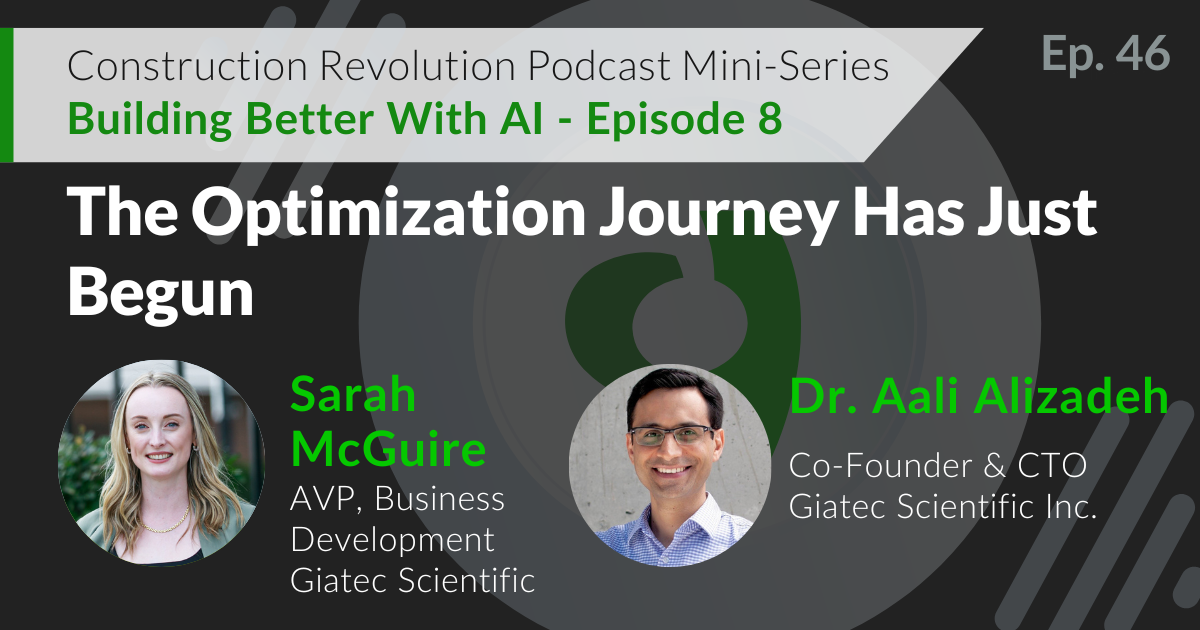
Episode 8 |
April 13, 2021
Cool Pavement and Urban Pavement Strategy
In This Episode
In this episode of Construction Revolution learn from MIT Concrete Sustainability Hub Executive Director, Dr. Jeremy Gregory, about the carbon uptake of concrete in the US pavement network. Discover the impact of cool pavement on the environment and how and why we need to rethink our urban pavement strategy to reduce carbon output.

Host
ERIC YEE
Content Marketing Manager, Giatec Scientific Inc.

Guest
Dr. JEREMY GREGORY
Executive Director, Concrete Sustainability Hub, Massachusetts Institute of Technology (MIT)
Podcast Transcript
Eric:
So, over the course of your career, what changes have you seen in how the construction industry, or even academia, pursue the development of technologies that allow for more sustainable building materials?
Jeremy:
I’d say one of the biggest changes is really just that people are talking about sustainability at all. I think that when it comes to topics of sustainability, the construction sector has really lagged other sectors in terms of making it a priority. I would say, generally I put sustainability in the category of motherhood and apple pie. No one’s against it, everyone likes it, but there’s a difference between that and having it be a real driver of your activities, and I think that’s how the construction sector has viewed sustainability. It’s something that everyone would like to take credit for, but it hasn’t really been a primary driver of decisions. What I think, that’s the part that I think is really changing recently, is that it really is starting to be something that people are taking into consideration and starting to think more about, how do we make this a regular part of our decisions?
Eric:
I’ve seen some talk of people, or projects, and even some department of transportation’s having sustainable guidelines in their project specs, which I think is a great step to force some organizations to make these moves.
Jeremy:
Yeah, we see that a little. In the US there’s certainly a lot of interest by departments of transportation and sustainability. I participate in this sustainable pavements technical working group that is organized by the U.S. Federal Highway Administration, and there’s a lot of transportation agencies that are in that. But, have having said that, there aren’t really a lot, at least in the US, that are explicitly taking that into consideration when making decisions. And I differentiate kind of broadly using sustainability. By that, I mean more like life cycle environmental impacts of let’s say, in that case pavements. Of course there’s a lot of local environmental considerations that they’re taking into consideration in different projects, but that’s different than thinking about like, “What are the climate change impacts of the materials that I use and the way I design and maintain my pavement.” That’s still a bit new. I would say that when it comes to construction materials, that in the US, at least on the building side, is where we’re seeing more pull in terms of taking environmental related considerations into materials and design decisions.
Eric:
Well, when we talk about the design decisions. One thing that I find, like you mentioned, there’s a lot of focus on the design side and the building side. But one area that I think has been kind of overlooked, but its gaining more attention, is what we do with the materials once projects have been completed, or there’s some kind of tear down. Can you touch upon what the materials recycling infrastructure looks like in the US, maybe broader?
Jeremy:
Yeah, sure. I think a lot of people don’t realize that we actually, at least in the US, generate more construction and demolition waste than municipal solid waste. And part of that is just because it’s so darn heavy. There’s a lot of it, but there’s actually a lot of that construction and demolition waste is concrete. And there’s quite a bit of reuse of concrete as what we call recycled concrete aggregates or RCA. I think at least on the one hand, that’s good. And that’s because sometimes it can be used to make new concrete, but a lot of times it’s just used in applications where we need aggregates. Which in the construction sector is plenty, like for a road base. That can be good because it prevents us from having to extract new aggregates, but, there still are a lot more opportunities to improve the materials collection and then reuse within the construction sector. I think we’re still quite a ways away from having more of a circular economy type mindset in the construction sector.
Eric:
Let’s learn a little bit more about your findings in your recent work on the carbon uptake of concrete in the US pavement network specifically. Could you explain your findings, particularly on how CO2 can be sequestered by the network?
Jeremy:
Sure. Yeah. This is basically part of a phenomenon that has been studied for a long time called carbonation in concrete. And it’s basically, there’s just a chemical reaction that naturally takes place slowly in concrete over time where it absorbs carbon dioxide, and then it gets chemically transformed to be part of the mineral structure of the concrete. That’s something that engineers have been studying for a long time, because in the past, there has been a potential for it to cause problems if there’s cracks in the concrete, and if there’s reinforcing steel, the net carbonation can lead to durability related issues. But it certainly doesn’t have to, properly designed concrete, it can have this carbonation and still perform just fine. People have started to make some estimates on just how much carbonation is happening in concrete, as we think more and more about climate change.
There’s a few reasons why the amount of carbonation that takes place, or we call it carbon uptake, why it varies and a couple things. It really depends on how much exposed concrete there is. So, obviously, you have to have the concrete exposed to the air. If you have a building where you have siding on it, you’re not going to get as much carbon uptake as an exposed concrete. If it’s painted, if it’s depending on the climate, and also depending on the kind of mixture that you’re using. Those are all factors that can affect how much carbon uptake that you can have.
In the study that we did recently, we chose pavements because it’s a bit more straightforward to estimate how much concrete is exposed, right? We have estimates of, in the US, how much exposed concrete pavements there are, and then we also have estimates of how much is what we call composite pavements. Where it’s most likely a concrete pavement that has asphalt on top of it, and as a consequence. We know kind of the approximate dimensions of the concrete. And so, we can estimate how much CO2 is absorbed during the life of the pavement, but it turns out there’s also opportunities for carbon uptake when concrete reaches its end of life.
And in particular, when you demolish it and open up all those surfaces, you drastically increase the amount of surface area that’s then exposed to the air and there’s even more opportunities for carbon uptake. Then when you talk about end of life, then there’s all kinds of opportunities, depending on if you have concrete that just sort of like in a pile, then there’s a lot of that exposed stuff that’s actually not, you know, there’s some exposed on the outside, but there’s a bunch that’s inside. As opposed to, if you spread it out more, that increases the amount of carbonation. We made some approximations on some of those things and then looked at the uncertainty associated with not knowing exactly what was going to happen. And that allowed us to then estimate just how much carbon uptake there was in the US pavement network.
Eric:
So, when the pavements at its end of life and it’s broken up, and the carbonation increases, have you seen any applications of where that concrete could, for lack of a better word, live for the rest of its life in that kind of material?
Jeremy:
Yeah, even when that happens, the carbonation is really happening in what we call the cement paste. Cement is what we start out with, the powder in concrete. We mix it with water, it hardens, and that’s the glue that helps to keep the aggregates and the sand together. So, what happens when we break it up, we’re generally breaking up that hardened cement paste, but what really is reused afterwards is the aggregates inside. We try and crush it up and remove all that cement paste, so we get the aggregates that we can reuse. But if you want the carbonation to take place, you want to spread it out where you’ve crushed it up enough to sort of create the rubble, but you don’t want to remove all that cement paste yet. That’s where you want to have even more.
So if it’s just sitting there absorbing CO2, it’s not really going to have much of an application, but something that people have said is like, “We could crush it up, spread it out, in some landfills, let it sit there for a while, absorb some CO2 and then use it again. That kind of process, I’ve only heard of that really being used in a few Scandinavian countries. I don’t think it’s really used elsewhere like that, but that’s the type of thing we wanted to understand. Just how much potential that there is, in which case, if we can create those kind of opportunities, then it could be beneficial.
Eric:
Well, the fact that there’s potential at all, I think is fantastic. Because I know, I think the concrete industry gets a lot of flack for being such a contributor. Especially on the processing side, when it’s being created and things like that, all of the carbon that can be from that process. But the fact that it can absorb carbon similar to how maybe trees do, but to a different extent, I think that’s a huge step forward for us to take in terms of trying to decide what to do with this material at different stages of its use cycle.
Jeremy:
Absolutely. Yeah. And I think that’s why we’re trying to run these numbers is just see how much potential is there throughout its life to absorb CO2, and how much is it at end of life as well.
Eric:
I know that your work discusses that California has unique climate conditions and even mixes on practices that result in like the largest carbon uptake during the use of pavement life. What are they doing differently than other areas of the country?
Jeremy:
Yeah, there is a couple reasons why we found they had a significant amount of carbon uptake, and it’s not just total amount. It was also one of the interesting things about California. When we looked at the breakdown of how much the carbon uptake came from what we call the use phase, while the pavements in service compared to end of life, was very different. In a lot of places, the amount of CO2 uptake at end of life was more than the use phase, whereas in California it was the opposite. I think about three quarters of the carbon uptake actually happened in the use phase. A couple of reasons, One, they just have a lot of pavements in general. That’s why the total number is like that. Texas also had a lot of CO2 uptake. But one of the things that’s different, is they had a lot more what we call a concrete pavement as opposed to a composite pavement.
What that means, there are a lot of States that have a lot of composite pavements, meaning that there’s concrete underneath, but asphalt on top. So, you don’t actually get that end of life, sorry, you don’t get the carbon uptake until end of life when you demolish that and then expose the concrete to the air as rubble. Whereas in California, they have a lot of concrete pavements that are exposed to the air. Hence, they get a lot more carbon uptake over its life. I mean, the climate plays a little bit of a role, that kind of mixtures that they use. They tended to use a little bit more cement in their mixtures, which actually helps when it comes to carbonation in terms of the chemical processes. But, it’s mostly just because they have more exposed concrete pavements.
Eric:
That makes a lot of sense. I guess on a related note, could you speak to your findings on the impacts of cool pavement and how we need to rethink our urban pavement strategy?
Jeremy:
Sure. Yeah, yeah. For us, a cool pavement is basically a pavement that has a higher albedo or reflectivity. Albedo is a measure that ranges from zero, something that absorbs all energy and is basically perfectly black, to one, and that reflects all energy and looks perfectly white. A lot of new asphalt pavements they’re albedo is pretty black, so it’s on the order of 0.05 to 0.1. As a consequence, when we put those in a lot of urban areas, they tend to absorb a lot of heat and that can contribute to the urban heat island effect. Which is something where, basically what it means, is that temperatures in an urban area are measurably higher than they are in a nearby rural area. Obviously all of the buildings, vehicles, things like that contribute to that heat being there.
A cool pavement is something that’s more reflective. It doesn’t absorb as much heat and there’s many ways you can achieve a cool pavement. One for those asphalt pavements, there’s a lot of people who are putting coatings on them and that can raise the albedo to say 0.3 or 0.4. Which doesn’t sound that high compared to one, but it’s pretty light gray actually. Obviously, we don’t want it too reflective, and then everyone has to drive around with sunglasses on all the time. But, as you know, being in Ottawa, apparently people do when there’s snow on the ground.
Eric:
Definitely.
Jeremy:
So, that’s one thing you can do is put on the coating. There’s also some ways you can change some of the aggregates that you use to have it be a little bit lighter, but it turns out that new concrete pavement also has an albedo around 0.3 and sometimes a little bit higher. There are also different ways you can increase that albedo by, once again, using different aggregates or even different binders. There were white cements that you can use to get it up to about 0.4 or higher.
These are all different strategies that can be used. And for a while, everyone kind of thought, people also have been looking at cool roofs in urban areas. Which is also a similar thing, but instead of a black tar on the roof, you can make it reflective. And the benefit of that is that it means there’s less heat being absorbed by the building, which means you have to use more increased air conditioning.
Now it turns out the mechanisms for pavements to evaluate their impact on temperatures is a little bit more complicated. Because particularly in urban areas, pavements can be in a canyon.
And what that means is that on the one hand increasing the albedo, it has an effect where it lowers the air temperatures. So that’s good, particularly in the summer. That means less air conditioning in the buildings. But also when you’re close by buildings, it means the radiation can bounce off the pavements and then go into the buildings. Meaning that actually that can also have an effect of increasing the amount of energy that’s in the buildings and the amount of air conditioning.
What we’ve been doing is some research to look at how do you balance these various effects? The fact that the increased albedo affects what we call the radiative forcing of the climate, meaning kind of like the energy balance at our atmosphere. And people at climate scientists study this all the time with melting ice caps. That’s changing the albedos. If you do deforestation, that changes albedo and how that affects our climate. So, changing a pavement albedo also affects the climate and generally leads to a cooling effect.
But, depending on where you are in a city it can, as I mentioned, increase the amount of building energy consumption as well. So, a lot of our research is figuring out there are some neighborhoods where the orientation and density of the buildings means it might not make as much sense, but there are some where buildings are more spread out where it would. But these are all kind of factors you have to take into account when trying to decide where’s the best place to use cool pavements.
Eric:
Well, it sounds like a really interesting area for urban planners to kind of consider as they move forward. Especially when you look at buildings and how to reduce the amount of carbon dioxide they emit. You try to use things like renewable energy and things like that. Where I would not have anticipated that what’s going on outside the building has such an impact on the performance or what goes on inside the building.
Jeremy:
Yeah. Yeah, absolutely. It’s kind of a surprise to us. I mean, the thing I didn’t mention is that actually, having a lower albedo like that can also help in the winter, right? So, for some places you also have to look at that dynamic. How are things different in terms of how it affects? It could have a benefit, meaning there’s less heating that needs to be done. You have to sort of look at those trade-offs and that’s the same thing with cool roofs, right? If you have a more reflective roof, it just means that in the winter, it’s not absorbing as much energy. But you have to look at those trade-offs and that’s why it depends on what kind of a climate you’re in, which sort of solution is going to make the most sense.
But another solution that I didn’t mention when it comes to cool pavements, is actually using what we call permeable pavements. And these are ones that basically they have more air content and are a bit more porous, and they’re meant to basically absorb water. If it’s raining on say a parking lot, the reason you have to have gutters all around it, is because the water hits that parking lot, it’s impervious to water. It goes off to the side and then goes down into our water treatment system. Well, a pervious pavement, the water goes in and it filters through the pavement and then goes underneath, and basically it goes back into the water table underneath that pavement. So, it means you need a much lower amount of water treatment systems all around it.
Also, in areas where you’re dealing with urban heat island, it can create an evaporative, cooling effect. Meaning that because there’s water in the pavement, the water goes in there and then as it evaporates going out, it creates a cooling effect. You can have both versions of that in asphalt and concrete. They can’t really be used in areas where you have a lot of traffic. You see them being used more in parking lots. But still, there’s a lot of parking lots where that can be used. So, that’s another interesting solution that people should consider.
Eric:
Yeah. I’m just thinking of all the giant parking lots are on malls and Walmarts and things like that, that it can be utilized there.
Jeremy:
Absolutely. Yeah. There’s a lot of opportunity and it’s striking. We put one in our town and one of the things they do to sort of test it out is take a firetruck and just spray the hose, like a high pressure hose, and you see sort of a conventional parking lot, it just goes right off, as I said, to the edge. Whereas in the previous one, it absorbs right in. So, it’s kind of neat, because it reduces the flood management that you have to deal with, particularly in high precipitation events.
Eric:
I’m curious. When you spray the fire hose, how quickly does it dissipate where you can’t see the water anymore?
Jeremy:
Yeah. I mean, generally the ones that I’ve seen, it goes in pretty quickly. And I’m sure if you look this up on the internet, there’s all kinds of videos you can find where they’ve taken a cross section and then pour water into it. And like I said, I’m trying to think of what’s a good analogy, but it’s like a sponge where it has air holes in it, but it’s set up so that it filters through. Even if you’re dumping it on top, it’ll be dripping heavily underneath. There obviously is only certain amount that it can take at any given time, but because it can be spread out so much, that’s what really helps. It can manage quite a bit of volume of water.
Eric:
I’ll definitely be looking at those videos after the show here, but, Dr. Gregory, I just have one last question before I let you go, and it’s not entirely construction related, but I was very surprised to learn that only 8.4% of end-of-life plastics were collected for recycling in the US in 2017. I would have thought that number would have been a much higher because I’ve grown up and always heard about reduce, reuse, recycle, and it seems to be so ingrained. So, what impact is that number and what kind of strategies do we need to improve our uptake?
Jeremy:
Yeah. Yeah. We’ve done quite a bit of research on the waste management system and in particular on plastics recycling. There’s a couple of different reasons as to why it’s such a low number. Some of it has to do with just basically technological limitations of recycling plastic. For example, pretty much any metal can be recycled infinitely, right? Like aluminum cans or steel cans. If producers could get all the material they needed, they would make aluminum cans out of a hundred percent recycled content. Whereas when it comes to paper and plastic, some of the chemical composition of it deteriorates over time. So you always need to add a little bit more what we call virgin content in order to create products. So, that’s one part of it.
The other thing is just that for some kind of plastics, it’s very energy intensive to actually transform them back into new products. And part of that is, maybe you’ve heard this term of polymers. A polymer is sort of the basic sort of chemical chain that makes up a particular kind of plastic. Like the number one that you see on the bottom of bottles, that’s polyethylene terephthalate, P-E-T. That’s the basic polymer, but the difference between a polymer and a plastic is that they usually add some other chemicals to it to give it a certain kind of property. That’s why you can have PET bottles, you can have PET food containers, you can have clothing made out of PET. Those are the same basic polymer chain, but they’re different plastics.
That makes it hard to recover them because when you get those plastics mixed in, you don’t have that pure PET strain. PET is number one. Number two is HDPE, high density polyethylene. That’s used in like, milk jugs. Both of those have a relatively robust system for collecting and then treatment, and if you look at those two numbers, the recycling is higher. I think it’s more in the 20 some percent.
The challenge is the other five numbers. Three, four, five, six, seven, where seven is other, right? There’s just, like I said, because of those different delimitations around being able to, in an economically efficient way, be able to turn those back into their original materials, is difficult. And then sorting among them is also difficult. Like with the ones it’s a lot of bottles. The twos, it’s a lot of milk jugs. Those are easier to sort, whereas the other kind of packaging it’s much harder to sort.
And then I’d say the other factor is just around collection. Even though a lot of people are recycling, we’re still, frankly, just not collecting nearly enough volume. Going back to the aluminum can example, I haven’t checked this recently, but at one point, in the US, we used about 350 million cans per day. Meaning, about one per person, per day. But we only collect, maybe half of those. As I mentioned, that’s why the producers can’t make a hundred percent recycled content. It’s just because they don’t get it all back.
We definitely need to improve our collection infrastructure around these things. If we can do sorting, that’s also going to improve things. But that last one about having economically efficient ways to be able to turn existing plastics into, or end of life plastics into new ones is still going to be a big challenge. And frankly, there just isn’t a lot of incentive for producers right now to redesign plastics so that they can be recovered and made into new products. There’s some real challenges there and I think that’s why the number is so low.
Eric:
So, I guess the only way that to incentivize it might be through like societal pressure or through policy of some kind I would think.
Jeremy:
Yeah. I think it’s both of those. One of the proposals that people talk about is called extended producer responsibility or EPR, which is used in many different kinds of cases. But when it comes to plastics, it basically means either financially or in some other way, you make the responsibility of a product at end of life, you assign that responsibility to the producer. It could mean the producer then has to invest in some of these other things, and that might incentivize them to change the way that they do things. But at least in the US, there’s very much this mindset that once the product goes to a consumer, it’s a consumer responsibility. And that’s why, as you said, that’s a common mindset and it’s understandably so, because financially there was a transaction that took place and it becomes sort of property. But when it comes to rethinking the way we do these systems, we might have to shift to more an extended producer responsibility type model to make significant gains.
Eric:
Yeah. I think it’s definitely a huge change in how we approach this problem in our mindset, such in that relationship between producers and consumers, like you said.
Jeremy:
Yes. Yeah. I mean, there are models for it. Like Europe, for over a decade, has had extended producer responsibility models for electronics to try to improve recycling there. So producers basically, they have a financial incentive there. There are many in the US, there are some States that also have an extended producer responsibility model for that, and that’s being extended to other kinds of products as well. There are systems being discussed for pharmaceuticals as well. Which sounds kind of funny, but there’s a lot of concern about how people dispose of pharmaceuticals and if they make it into the water stream. If they are in the waste system, it’s hard to get them out, and that can affect marine wildlife and things like that. That kind of model is definitely something that’s gaining traction, but for it to work, you really need to have an engaged producers as part of that. And sometimes they are willing to come together, and sometimes it’s more difficult.
Eric:
Well, Dr. Gregory, thank you so much for coming on the show today. I’ve learned a lot and I’m sure our audience has too.
Jeremy:
Great. It’s been my pleasure. Thank you.
Eric:
Thank you.
Other Related Episodes
Episode 50 |
October 3, 2024
AI and Evolving Concrete Standards
Our “Building Better with AI” mini-series is back by popular demand! Originally planned as an eight-episode series, the overwhelming response from our listeners has brought us back for more. Please join us for our ninth episode, “AI and Evolving Concrete Standards”! In this episode, we’re unpacking the challenges of concrete constructability, why industry stakeholders must improve communication, and how AI can help bridge this gap. Joining us are Cary Kopczynski, CEO, Cary Kopczynski & Company, and Alana Guzzetta, National Research Lab Manager, Vulcan Materials. Together, they explore the impact of evolving ACI standards on concrete performance, constructability, and sustainability, along with the major opportunities and challenges that AI presents as the industry advances. Filled with insights and a call to action for the entire industry, this episode is a must-listen for professionals eager to stay ahead in the concrete world. Tune in for a conversation that’s not just about keeping up with change but leading it!
Full McKinsey Report:
REINVENTING CONSTRUCTION: A ROUTE TO HIGHER PRODUCTIVITYPLAY
Episode 48 |
August 22, 2024
Streamlining Green Construction with EPDs
In this episode of The Construction Revolution Podcast, we welcome Chris Erickson of Climate Earth. Chris shares how the latest advancements in Environmental Product Declarations (EPDs) are transforming sustainability efforts in the construction industry. With his extensive knowledge in environmental impact data and sustainable practices, Chris delves into the innovative tools and solutions that are simplifying EPD creation and management for construction companies. Join us as Chris discusses how Climate Earth’s technology is making it easier for companies to measure and reduce their ecological footprint, ensuring compliance with regulatory requirements and enhancing their commitment to sustainability. Don’t miss this insightful conversation on the future of sustainable construction and the role EPDs play in leading the industry towards a greener future.
PLAY
Episode 46 |
July 11, 2024
The Optimization Journey Has Just Begun
In the eighth and final episode of our "Building Better with AI" mini-series, "The Optimization Journey Has Just Begun," we’re introducing a unique twist. This time, Sarah McGuire, AVP Business Development, switches roles and steps into the hot seat to answer questions rather than ask them. To guide this special conversation, we’ve brought back our Co-Founder and CTO of Giatec, Aali Alizadeh, Ph.D. This episode provides a comprehensive update on where SmartMix, Giatec’s AI-powered mix management system, currently stands. Sarah and Aali discuss the significant progress made since recording the first episode in December 2023, highlighting the challenges overcome and valuable lessons learned during the implementation of SmartMix. Listeners will gain insight into customer success stories and the transformative impact SmartMix has had on the concrete industry. This episode offers a reflective and forward-looking perspective on the journey of SmartMix, showcasing how it continues to drive innovation and efficiency. Tune in for a compelling discussion that not only recaps our journey but also looks ahead to the future of AI in the concrete industry. Don’t miss this insightful and engaging conclusion to our mini-series!
PLAY
Want to Be a Guest Speaker, Sponsor, or Just Have a Question for Us? Fill In the Form!





